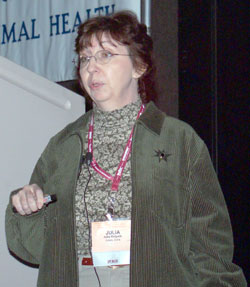9:15 am - 12:30 pm • Yuma 24-25 Rooms
PR 105: BVD Control & Your Operation
Dr. Julia Ridpath, USDA/ARS; Dr. Bob Larson, Univ. of Missouri; Dr. Dan Grooms, Michigan State Univ.; and Dr. Patty Scharko, Univ. of Kentucky, Dr. Dale M. Grotelueschen, Pfizer Animal Health, Moderators
BVD Control & Your Operation
 |
| Bovine viral diarrhea causes an estimated $35-$56 million annually in calf losses, said Julia Ridpath of USDA/ARS. |
Bovine viral diarrhea (BVD) was one of a number of lesson options for pupils attending the Cattlemen’s College® sponsored by Pfizer Animal Health Jan 28. Dan Grooms, Michigan State University (MSU), Bob Larson, University of Missouri (MU), and Julia Ridpath, U.S. Department of Agricultural (USDA) Agricultural Research Service (ARS) were on hand to speak and answer questions during a three-hour educational workshop.
Presenters spoke about what cattlemen need to know about BVD, its effects on production and profitability, when and what to look for, and the role of vaccinations in an effort to help producers develop a plan to prevent and control the spread of the virus in their herds.
BVD viruses (BVDV) can be found in ruminants worldwide, Ridpath said. BVDV can reduce growth rates; cause reproductive failure; weaken the immune system, allowing the onset of other infections; and cause death. She estimated calf losses due to BVD at $35-$56 million.
A tremendous added cost accompanies a BVD infection, Larson said. BVDV can increase the incidence of scours, pneumonia and pinkeye in calves, adding to the cost of death loss, treatment and reduced performance. Reduction in cow fertility, delayed pregnancy and abortion also contribute to profit losses.
Detecting BVD can be difficult, Ridpath said, as “classic” signs are unreliable. Surveying epidemiology (for lesions), considering traffic signals or changes, observing vulnerable populations and considering pathogens provide the most effective means of detection.
Although vaccines do not prevent BVD 100% of the time, they are still highly effective in preventing the virus, Grooms said. There are many vaccines available. Location, exposure, time of year, management and economics are some considerations when choosing a vaccine.
To eliminate BVD from a herd once discovered, the persistently infected (PI) animals must be removed and euthanized, Larson said. These animals are born infected and constantly shed the virus, infecting other animals.
Larson, along with the Academy of Veterinary Consultants, developed herd-management guidelines for both infected and BVD-free herds. The guidelines illustrate extensive testing and separation procedures to rid a herd of the disease and to prevent the introduction of BVD.
— by Cara Bieroth
Click here to view the agenda for this presentation.
Click here to view the Grooms' PowerPoint presentation, "Role of Vaccination in Control of BVDV."
Click here to view the PowerPoint presentation,"BVD Decision/Management Guidelines for Beef Cattle Veterinarians."
Click here to view Larson's presentation, "Economic and Production Effects of BVD."
Click here for audio file of first half of presentation
Click here for audio file of second half of presentation
You will need Windows Media Player to listen to audio archives of the presentations.
Click here to download a free version.

